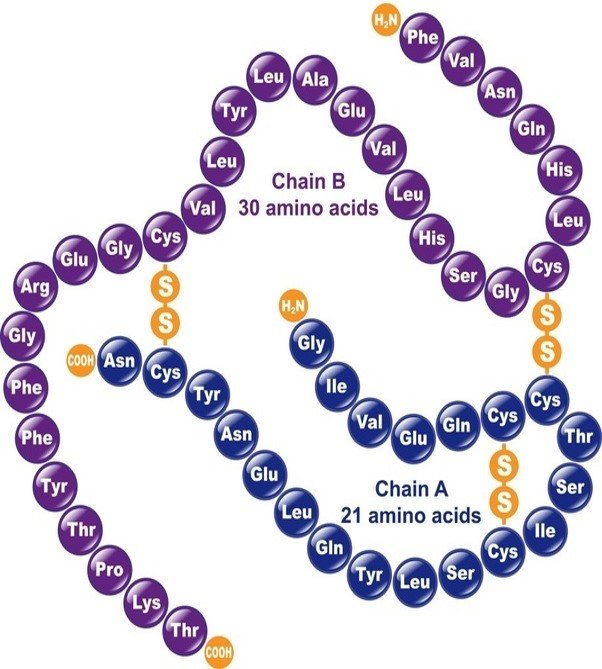Diabetes mellitus - Human Energy Metabolism #3
This is the third article in my series on the Human Energy Metabolism.
If you are interested, the first two articles can be found here:
From now on we will turn toward quite specific issues of nutritional biochemistry. With this article I will provide a quick discussion of Diabetes mellitus - a metabolic disease that everyone has heard of, but which is still not perfectly understood.
Aspects of nutritional Biochemistry I

Image Source
Diabetes mellitus
In this disease, the hormon insulin is either not produced in sufficient amounts or target tissues do not respond properly. The consequence is, that blood glucose levels rise to abnormal levels, which leads to a "spill over" into the urine, providing a useful diagnostic criterion for the detection of the disease. This phenomenon is also known as "honey-sweet flow".
Despite the high levels of glucose in the blood, glucose needy cells „starve“ due to the absence of a functioning insulin-stimulated entry process. Cells respond by increasing triacylglycerol hydrolysis, fatty acid oxidation, gluconeogenesis and ketone body formation (ketosis).

Under these circumstances keton bodies reach abnormally high levels in the blood and, as they are acids, this leads to an increased excretion of H+, Na+, K+, phosphate and water by the kidney. This in turn causes dehydration of the body and a decrease in blood volume. Hence excessive thirst is a classical symptom of Diabetes!
Furthermore, the formed ketone bodies formed can be discharged via the breathing air. This may also be used for diagnostics. E.g. acetone in the air can be detected both by special measuring devices as well as by trained diabetics-warning dogs. This allows an early detection and prevention of an upcoming hypoglycemic crisis!
Insulin-dependent Type I Diabetes mellitus
Type I Diabetes results from a lack of insulin due to deficient production in pancreatic β-cells which have been destroyed by an autoimmune attack. The disease emerges when more than 80 % of the β-cells have been destroyed.
Type I Diabetes develops during childhood and patients are required to maintain a strict diet accompanied by regular insulin doses. Despite this treatment patients have a 30 % reduced life span. This results from degenerative complications such as kidney malfunction as well as nerve and cardiovascular impairments.
Non-insulin-dependent Type II Diabetes mellitus
Type II Diabetes accounts for > 90 % of all cases with stunning 18 % of the population over 65 years of age being affected. Type II Diabetes preferentially occurs in obese individuals. Those patients have normal or even higher blood insulin levels. This type of diabetes arises from a paucity of insulin receptors on usually insulin-responsive cells. As a consequence, these cells do not respond normally to insulin and they are said to be „insulin-resistant“.
Again, blood glucose levels are elevated, particularly after a meal. Although some forms of type II diabetes (ca. 5 %) appear to be related to mutations in the insulin binding receptor, overeating and the consequential suppression of insulin receptor synthesis appear to be a major factor in the development of the disease. This hypothesis accounts for the observation that diet alone often decreases the severity of the disease - a certainly remarkable fact.
The role of Insulin
Insulin binds to the extracellularly located α-subunits of the dimeric, transmembrane insuline receptors. Upon insulin binding, the intracellular tyrosine kinase domain undergoes a conformational change leading to autophosphorylation. This in turn increases the tyrosine kinase activity. Insulin receptor substrate-1 (short IRS-1) binds to the receptor, is phosphorylated and activates other signalling pathways: gene activations, MAP kinases, RAS, etc.
This clearly shows the central role and thus importance of the insulin hormone for the proper function of our energy metabolism.

Primary structure of human insuline - Image Source
Facts and Statistics on Diabetes mellitus
- Worldwide, over 400 million people are affected by some form of diabetes.
- In Central Europe, the number of diabetics has increased by 40 % since 1998.
- Diabetes may lead to blindness, kidney failure, heart attacks, strokes and the need for lower limb amputations.
- Kidney failure due to diabetes is responsible for a massive 26 % of all new dialysis patients.
- In a developed country like Austria, 62 % of the necessary amputations are due to diabetes.
- Since the disease is spreading, the WHO estimates that diabetes will be the seventh leading cause of death in 2030!
- A healthy diet, regular and sufficient physical activity as well as the maintenance of a normal body weight are promising ways to delay or even totally prevent the onset of type II diabetes.
I hope you learned something new and interesting from this article! Since I will continue with this series, dealing with Starvation and Fasting in the next article, I hope you all will stay tuned for more. :)
mountain.phil28
References:
- A article about diabetics-warning dogs
- Statistics on Diabetes mellitus in Austria
- Worldwide Statistics on Diabetes mellitus
- Various Wikipedia Articles as referenced in the text
- Further information and non-direct cited images are taken from "Biochemistry I" lectures at the TU Graz.

Sweet articel ;)
by the way, we humans can smell the 'over flow' of keton, some say, it smells like cotton candy :)
Resons for early dia-1 deaths is also, stroke
Way great easy, information :D thumb up and gold star :D well done sweets :D
Thx for the nice comment!
:-)
I heard that too, but I guess we humans are too little sensible to act as preventive measuring tool. :-D
Best,
mountain.phil28
PS:
I stated "stroke" in point 3 of the fact collection. ;-)
:D
WE<< is the diabetic^^ smell a LOT, it comes out of our pores, not just our breath ;) BUT nooo , humans cant be used as measuring tools as our smell receptors very to much between individuals ;) & also it depends on our learning, as in if we are used to use our nose :p lol
P.P.S i know BUT im after >>>
Reason or smarta..Y ;) stroke is(should be number 2 there) ;) LOL tell your sis i WAVED^^ ;)
Ohh Ohh And side note to the dia dog :D do you knooooow, they are actually trained to detect the low sugar??? which isent always by smell but behaviour?
I knew what you were after. :-P
Just tried to talk my was out in a proper way. :D
Yes, those dogs do not only depend on their noses. Thanks for stating this. ;-)
Best,
mountain.phil28
he he
hm i kind of thought so lol , you thought, i just give up? roll over and say -yes youR right? ;)LOL
oh oh yes &&& noo, the reason one gets dia dogs is ACTUALLY to detect low sugar As thats deadly O.o and most pumps now a days are to slow with their 30min lay back, to detect the sugar going down, soo now a days the dogs are trained to push a button to turn of the pumps too :D
<will sip it now^^ dont reallyyy wana buuz ;)
I just tried to fulfill your requirement of mentioning this matter. ;)
I never said, that those dogs do not detect low sugar. Since keton body formation is a consequence of low sugar / hypoglycaemia it is one indicator upon which those dogs can rely on. :)
Hoping for a now satisfied swedish dragon,
mountain.phil28
ha ha you always do sweety :D💖
ohh i knooow, you never did :) i just go for stuff that isent said & i find might be good, tooo be said ;)
<is content^^ :P LOL hmm for now :P ;)
Health information is very useful, thanks for sharing knowledge that is very useful for us false😎😎😎
nice work sis.thnx :)
great post bro. please support us by doing a simple vote.
regards.
Very nice post ;)